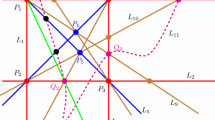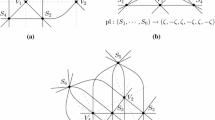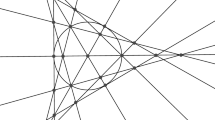Abstract
In his Ph.D. thesis, Cadegan-Schlieper constructs an invariant of the embedded topology of a line arrangement which generalizes the \(\mathcal {I}\)-invariant introduced by Artal, Florens and the author. This new invariant is called the loop-linking number in the present paper. We refine the result of Cadegan-Schlieper by proving that the loop-linking number is an invariant of the homeomorphism type of the arrangement complement. We give two effective methods to compute this invariant, both are based on the braid monodromy. As an application, we detect an arithmetic Zariski pair of arrangements with 11 lines whose coefficients are in the 5th cyclotomic field. Furthermore, we also prove that the fundamental groups of their complements are not isomorphic; it is the Zariski pair with the fewest number of lines which have this property. We also detect an arithmetic Zariski triple with 12 lines whose complements have non-isomorphic fundamental groups. In the appendix, we give 29 combinatorial types which lead to similar ordered arithmetic Zariski pairs of 11 lines. To conclude this paper, we give a additivity theorem for the union of arrangements. This first allows us to prove that the complements of Rybnikov’s arrangements are not homeomorphic, and then leads us to a generalization of Rybnikov’s result. Lastly, we use it to prove the existence of homotopy-equivalent lattice-isomorphic arrangements which have non-homeomorphic complements.





Similar content being viewed by others
Notes
We should also mention here the refinement obtained by Jiang and Yau [25] who proved that the homeomorphism type of the complement determines the intersection lattice.
In the general case of algebraic plane curves, a Zariski pair is said to be arithmetic if the equations of their arrangements are conjugated in a Galois field. Such pairs have been extensively studied by authors like Degtyarev, Oka, Shimada or Tokunaga. Note that the Zariski pairs of arrangements given in [4, 19] are arithmetic.
The boundary manifold is the boundary of a regular tubular neighborhood of \(\bigcup _{L\in \mathcal {A}}L\). It is a graph 3-manifold determined by the combinatorics of \(\mathcal {A}\). This manifold has been studied in [13].
See [34] for more details about complex reflection groups.
The ordered (resp. oriented) topological type of \(\mathcal {A}\) is the class of homeomorphism of \(\mathbb {C}\mathbb {P}^2\) which fixes \(\bigcup _{L\in \mathcal {A}}L\) and respects a fixed complete order on \(\mathcal {A}\) (resp. the global orientation of \(\mathbb {C}\mathbb {P}^2\) and the local orientation of the meridians).
If \(\mathcal {A}\) is a pencil then its topology is combinatorially determined.
It is compact, orientable, irreducible, and has an embedded incompressible surface.
Note that this isomorphism between the ordered combinatorics is unique.
To lighten the notation a sub-arrangement \(\mathcal {A}_P=\{L_{i_1},\ldots ,L_{i_m}\}\) is denoted by \(\{i_1,\ldots ,i_m\}\).
The braids \(B_{ {(P\rightarrow L)} }\) are given as tuple of integer \((i_1,\ldots ,i_k)\), where a positive integer i in the tuple indicates a positive crossing between the strands number i and \(|i+1|\); while a negative i indicates a negative crossing between strands numbers |i| and \(|i|+1\). The singular points \(P_{i_1,\ldots , i_m}\) are expressed as the tuple \([i_1,\dots ,i_m]\).
A wiring diagram of \(\mathcal {M}_2\) (resp. \(\mathcal {M}_4\)) can be obtained from the one of \(\mathcal {M}_3\) (resp. \(\mathcal {M}_1\)) by the inversion of the sign of the virtual crossings.
This can be viewed as a consequence of Theorem 5.5 presented below.
We consider the orders given by the indices, i.e. \(L^k_i< L^k_j \Leftrightarrow i<j\).
A more detailed list with the equations of the realizations and the automorphism groups is given in the first version of this paper available at arXiv:2004.03550.
References
Artal, E.B., Martín-Morales, J., Cogolludo-Agustín, J.I.: Triangular curves and cyclotomic Zariski tuples. Collect. Math. 71, 427–441 (2020)
Arvola, W.A.: The fundamental group of the complement of an arrangement of complex hyperplanes. Topology 31(4), 757–765 (1992)
Bartolo, E.A., Ruber, J.C., Augustín, J.I.C.: Essential coordinate components of characteristic varieties. Math. Proc. Camb. Philos. Soc. 136(2), 287–299 (2004)
Bartolo, E.A., Ruber, J.C., Agustín, J.I.C., Buzunáriz, M.M.: Topology and combinatorics of real line arrangements. Compos. Math. 141(6), 1578–1588 (2005)
Bartolo, E. A., Ruber, J.C., Agustín, J.I.C., Buzunáriz, M.Á.M.: Invariants of combinatorial line arrangements and Rybnikov’s example. In: Singularity theory and its applications. Papers from the 12th MSJ International Research Institute of the Mathematical Society of Japan, Sapporo, Japan, September 16–25, 2003, pp. 1–34. Mathematical Society of Japan, Tokyo (2006)
Bartolo, E. A., Cogolludo, J.I., Tokunuga, H.: A survey on Zariski pairs. In: Algebraic geometry in East Asia—Hanoi 2005. Proceedings of the 2nd International Conference on Algebraic Geometry in East Asia, Hanoi, Vietnam, October 10–14, 2005, pp. 1–100. Mathematical Society of Japan, Tokyo (2008)
Bartolo, E.A., Cogolludo-Agustín, J.I., Guerville-Ballé, B., Marco-Buzunáriz, M.: An arithmetic Zariski pair of line arrangements with non-isomorphic fundamental group. Rev. R. Acad. Cienc. Exactas Fís. Nat. Ser. A Mat. RACSAM 111(2), 377–402 (2017)
Bartolo, E.A., Florens, V., Guerville-Ballé, B.: A topological invariant of line arrangements. Ann. Sc. Norm. Super. Pisa Cl. Sci. (5) 17(3), 949–968 (2017)
Bartolo, E.A., Guerville-Ballé, B., Viu-Sos, J.: Fundamental groups of real arrangements and torsion in the lower central series quotients. Exp. Math. 29(1), 28–35 (2020)
Brieskorn, E., Knörrer, H.: Plane algebraic curves. In: Transl. from the German by John Stillwell, vol. VI, 721, pp. DM 98.00. Birkhäuser, Basel (1986)
Buzunáriz, M.Á.M.: A description of the resonance variety of a line combinatorics via combinatorial pencils. Graphs Comb. 25(4), 469–488 (2009)
Cadegan-Schlieper, W.: On the geometry and topology of hyperplane complements associated to complex and quaternionic reflection groups. PhD thesis, University of California-Los Angeles (2018)
Cohen, D.C., Suciu, A.I.: The boundary manifold of a complex line arrangement. In: Proceedings of the Conference on Groups, Homotopy and Configuration Spaces, University of Tokyo, Japan, July 5–11, 2005 in Honor of the 60th Birthday of Fred Cohen, pp. 105–146. Geometry & Topology Publications, Coventry (2008)
Cohen, D.C., Suciu, A.I.: The braid monodromy of plane algebraic curves and hyperplane arrangements. Comment. Math. Helv. 72(2), 285–315 (1997)
Falk, M., Randell, R.: On the homotopy theory of arrangements. II. In: Arrangements—Tokyo 1998. Proceedings of a workshop on mathematics related to arrangements of hyperplanes, Tokyo, Japan, July 13–18, 1998. In honor of the 60th birthyear of Peter Orlik, pp. 93–125. Kinokuniya Company Ltd., Tokyo (2000)
Fan, K.-M.: Direct product of free groups as the fundamental group of the complement of a union of lines. Mich. Math. J. 44(2), 283–291 (1997)
Florens, V., Guerville-Ballé, B., Marco-Buzunariz, M.A.: On complex line arrangements and their boundary manifolds. Math. Proc. Camb. Philos. Soc. 159(2), 189–205 (2015)
Goodman, J.E.: Proof of a conjecture of Burr, Grünbaum, and Sloane. Discrete Math. 32, 27–35 (1980)
Guerville-Ballé, B.: An arithmetic Zariski 4-tuple of twelve lines. Geom. Topol. 20(1), 537–553 (2016)
Guerville-Ballé, B.: Multiplicativity of the \(\cal{I}\)-invariant and topology of glued arrangements. J. Math. Soc. Japan 70(1), 215–227 (2018)
Guerville-Ballé, B.: Topology and homotopy of lattice isomorphic arrangements. Proc. Am. Math. Soc. 148, 2193–2200 (2020)
Guerville-Ballé, B., Viu-Sos, J.: Configurations of points and topology of real line arrangements. Math. Ann. 374(1–2), 1–35 (2019)
Haken, W.: Ein Verfahren zur Aufspaltung einer 3-Mannigfaltigkeit in irreduzible 3- Mannigfaltigkeiten. Math. Z. 76, 427–467 (1961)
Haken, W.: Theorie der Normalflächen. Ein Isotopiekriterium für den Kreisknoten. Acta Math. 105, 245–375 (1961)
Jiang, T., Yau, S.S.-T.: Topological invariance of intersection lattices of arrangements in \(\mathbb{CP}^ 2\). Bull. Am. Math. Soc. New Ser. 29(1), 88–93 (1993)
MacLane, S.: Some interpretations of abstract linear dependence in terms of projective geometry. Am. J. Math. 58, 236–240 (1936)
Moishezon, B.G.: Stable branch curves and braid monodromies. Algebraic geometry. In: Proceedings Conference, Chicago Circle 1980. Lecture Notes in Mathematics, vol. 862, pp. 107–192 (1981)
Nazir, S., Yoshinaga, M.: On the connectivity of the realization spaces of line arrangements. Ann. Sc. Norm. Super. Pisa Cl. Sci. (5) 11(4), 921–937 (2012)
Neumann, W.D.: A calculus for plumbing applied to the topology of complex surface singularities and degenerating complex curves. Trans. Am. Math. Soc. 268, 299–343 (1981)
Orlik, P., Solomon, L.: Combinatorics and topology of complements of hyperplanes. Invent. Math. 56, 167–189 (1980)
Orlik, P., Terao, H.: Arrangements of hyperplanes, vol. 300. Springer, Berlin (1992)
Rybnikov, G.L.: On the fundamental group of the complement of a complex hyperplane arrangement. Funct. Anal. Appl. 45(2), 137–148 (2011)
Salvetti, M.: Arrangements of lines and monodromy of plane curves. Compos. Math. 68(1), 103–122 (1988)
Shephard, G.C., Todd, J.A.: Finite unitary reflection groups. Can. J. Math. 6, 274–304 (1954)
Suciu, A.I.: Hyperplane arrangements and Milnor fibrations. Ann. Fac. Sci. Toulouse Math. (6) 23(2), 417–481 (2014)
Waldhausen, F.: Eine Klasse von 3-dimensionalen Mannigfaltigkeiten. I, II. Invent. Math. 3, 308–333 (1967)
Waldhausen, F.: On irreducible \(3\)-manifolds which are sufficiently large. Ann. Math. (2) 87, 56–88 (1968)
Westlund, E.: The boundary manifold of an arrangement. PhD thesis, University of Wisconsin-Madison (1997)
Ye, F.: Classification of moduli spaces of arrangements of nine projective lines. Pac. J. Math. 265(1), 243–256 (2013)
Zariski, O.: On the problem of existence of algebraic functions of two variables possessing a given branch curve. Am. J. Math. 51, 305–328 (1929)
Zariski, O.: On the irregularity of cyclic multiple planes. Ann. Math. (2) 32, 485–511 (1931)
Acknowledgements
During this work the author have been supported, first by the postdoctoral grant #2017/15369-0 of the Fundação de Amparo à Pesquisa do Estado de São Paulo (FAPESP), second by the Polish Academy of Sciences, and third by JSPS KAKENHI Grant Number JP17H06128. The author would like to thank J. Viu-Sos for all their rewarding discussions and all his remarks/comments which greatly contributed to improve the quality of this article. He is also grateful to E. Hollen for her efficient and careful proofreading of this manuscript.
Author information
Authors and Affiliations
Corresponding author
Additional information
Publisher's Note
Springer Nature remains neutral with regard to jurisdictional claims in published maps and institutional affiliations.
Appendices
Appendix A: Values for the arrangements \(\mathcal {M}_i\)
1.1 Generator of \({{\,\mathrm{TLG}\,}}(C,\mathbb {Z}/5\mathbb {Z})\)
The generator \(\Lambda _0\) of \({{\,\mathrm{TLG}\,}}(C,\mathbb {Z}/5\mathbb {Z})\) is given by the following characters \(\lambda _{ {(P\rightarrow L)} }\).

1.2 The upper-linking numbers of \(\mathcal {M}_1\)
The values of the upper-linking numbers of the braid \(B_{ {(P\rightarrow L)} }\) are given below. The values denoted with a \(=^*\) symbol have been simplified using the property \(\sum _{L\in \mathcal {A}} m_L = 0\).

Appendix B: List of arithmetic Zariski pairs with 11 lines
Each one of following combinatoricsFootnote 15 admits four realizations Galois conjugated in the 5th cyclotomic fields and its tensor linking groups with coefficients in \(\mathbb {Z}/5\mathbb {Z}\) is isomorphic to \(\mathbb {Z}/5\mathbb {Z}\). Furthermore, their realizations can be distinguished using the loop-linking number. The following list has been obtained using a computer-aid checking of all the lines combinatorics with 11 lines. First, we listed the combinatorics which admits a non-trivial tensor linking group with coefficients in \(\mathbb {Z}/p\mathbb {Z}\) for \(p=5,7,9,11\). Then, we determined the moduli-space of each of these combinatorics, and for the one which have several connected-components, we computed their loop-linking numbers. To our knowledge and our computations, the following list together with the examples obtained from the ordered Zariski pair of Sect. 4.1 and the one of [19], is the complete list of the combinatorics which leads to an arithmetic Zariski pair with 11 lines that can be detected by the loop-linking number with coefficient in \(\mathbb {Z}/p\mathbb {Z}\) for \(p=5,7,9,11\).
Rights and permissions
About this article
Cite this article
Guerville-Ballé, B. The loop-linking number of line arrangements. Math. Z. 301, 1821–1850 (2022). https://doi.org/10.1007/s00209-021-02953-x
Received:
Accepted:
Published:
Issue Date:
DOI: https://doi.org/10.1007/s00209-021-02953-x




